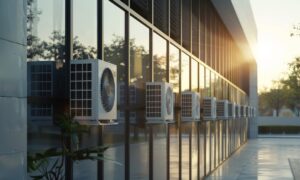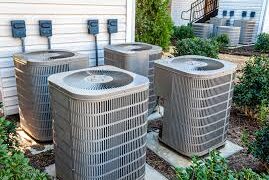With rising energy prices, many homeowners are looking for ways to reduce the energy consumption of their HVAC systems. The good news is that there are many ways to accomplish this goal. In this blog post, we will explore five of the most effective ways to reduce the energy consumption of your HVAC system. Keep reading to learn more!
Ways to Reduce Energy Consumption of an HVAC System
Reducing the energy consumption of an HVAC system is essential for saving energy and money. Here are five ways to reduce the energy consumption of an HVAC system:
1. Install a Programmable Thermostat
Installing a programmable thermostat is a great way to reduce the energy consumption of a home’s HVAC system. This device is designed to monitor and maintain a home’s temperature within a specific range. The user can program the thermostat according to their desired temperatures, which will help maintain a consistent and comfortable interior environment.
The thermostat can be programmed around the user’s schedule, allowing it to drop to a lower temperature when the user is away and rise when they’re home. This helps conserve energy, as the HVAC system won’t have to work hard to maintain the temperature.
Programmable thermostats are generally very simple to install, with many models being able to be installed without the help of HVAC professionals. The thermostat is typically mounted on a wall, and the user will need to connect the wiring from the HVAC system to the device.
After the wiring is connected, the user will program the thermostat with their desired temperature ranges, and the device will start to monitor and adjust the interior temperature. The user will also be able to monitor the energy usage with the thermostat, seeing how much energy is saved by using this device.
Overall, installing a programmable thermostat is a great way to reduce the energy consumption of a home’s HVAC system. This device can be easily installed and programmed and will help to maintain a comfortable interior environment while also providing energy savings.
2. Utilize Proper Insulation
Using proper insulation is one of the most effective ways to reduce the energy consumption of HVAC systems. When insulation is installed correctly, it helps keep the heated or cooled air inside the building while preventing the outside air from entering. This means that the HVAC system does not need to work as hard to maintain a comfortable temperature inside the building. Additionally, proper insulation helps to prevent heat loss through the walls and floors, which helps to reduce energy consumption.
There are several types of insulation available, each of which has its own unique benefits. For example, fiberglass insulation is a popular choice due to its affordability. Cellulose insulation is made from recycled materials and is very eco-friendly.
On the other hand, spray foam insulation creates an air-tight seal and effectively reduces energy consumption. Whichever type of insulation is chosen, it is important to ensure it is properly installed and maintained to ensure maximum energy efficiency.
Finally, the R-value of insulation should also be considered to ensure maximum energy savings. The R-value measures the insulation’s ability to resist heat transfer, with higher R-values indicating better insulation. It is crucial to select insulation with the appropriate R-value for the climate and building type to ensure maximum energy efficiency. By utilizing proper insulation, the energy consumption of HVAC systems can be significantly reduced.
3. Change Air Filters Regularly
Keeping your HVAC system running smoothly is key to reducing energy consumption and costs. One important step in maintaining your HVAC system is changing the air filters regularly. Air filters are a crucial component of the HVAC system, as they help to trap dust and other particles that would otherwise cause damage or impede the system’s efficiency. By changing the air filter regularly, you can ensure that the HVAC system runs clean and that airflow is unrestricted.
When changing the air filter, it is important to use the correct type for your system. Different systems require different types of air filters, so it is important to refer to the manufacturer’s instructions or consult a professional to ensure that you are using the correct type. It is also important to check the filter frequently and replace it when it gets clogged with dust and other debris. Depending on the environment, the filter should be replaced every one to three months and ensure they fit properly with the HVAC plenum for optimal performance.
By changing the air filters regularly, you can keep your HVAC system running properly and reduce energy consumption. Not only will this help to reduce your energy bills, but it will also help to extend the life of your HVAC system. Regular maintenance and filter changes are essential for keeping your HVAC system running efficiently and working to its full potential.
4. Seal Gaps and Cracks
Sealing gaps and cracks in an HVAC system is an effective way to reduce energy consumption. Proper sealing is essential for the efficient operation of an HVAC system, as it reduces the amount of air leakage from the ducts, reducing the amount of energy needed to cool or heat the space. This not only reduces energy consumption but also reduces the overall cost of operation.
When sealing an HVAC system, the goal is to create a continuous seal around the entire system, from the ducts to the walls and the floor. This can be achieved using various materials and techniques, including weatherstripping, caulking, and insulation. Additionally, installing an air barrier or vapor barrier between the indoor and outdoor environments can also help reduce air leakage and further reduce energy consumption.
When properly sealed, an HVAC system can reduce energy consumption by up to 30%. This can result in significant savings on energy bills, and can also help extend the system’s life by preventing damage caused by air leakage. Proper sealing of an HVAC system is essential to keeping energy bills low and maximizing the system’s efficiency.
5. Utilize a Smart HVAC System
Using an intelligent HVAC system is one of the most effective ways to reduce energy consumption. Smart HVAC systems can sense the surrounding environment’s temperature and adjust the system’s energy output accordingly. This helps to maintain optimal temperature levels and reduce energy waste.
Additionally, smart HVAC systems are equipped with sensors that are able to detect changes in air quality, such as humidity and air pressure. This allows the system to adjust the temperature and climate control settings according to the conditions of the environment.
Smart HVAC systems also can automate energy-saving functions, such as turning off the system when the desired temperature has been achieved, or when the room is unoccupied. This helps to maximize efficiency and minimize energy wastage. Furthermore, many of these systems come with advanced algorithms that enable them to run more efficiently, reducing energy consumption and improving overall performance.
Smart HVAC systems offer a wide range of features, such as remote access control, custom climate settings, and energy monitoring, all of which help to improve user experience and reduce energy consumption.
Conclusion
In conclusion, reducing the energy consumption of the HVAC system starts with the design and installation of the system. The right system with the right components and settings will help maximize the system’s efficiency and minimize energy consumption. It is important to integrate the system into the overall energy management of the building and use proper insulation, air sealing, and energy-efficient components.
Additionally, regular maintenance is essential to ensure the system works as efficiently as possible. With the right design, installation, and maintenance, energy consumption of the HVAC system can be minimized, and the costs associated with it can be reduced.



































